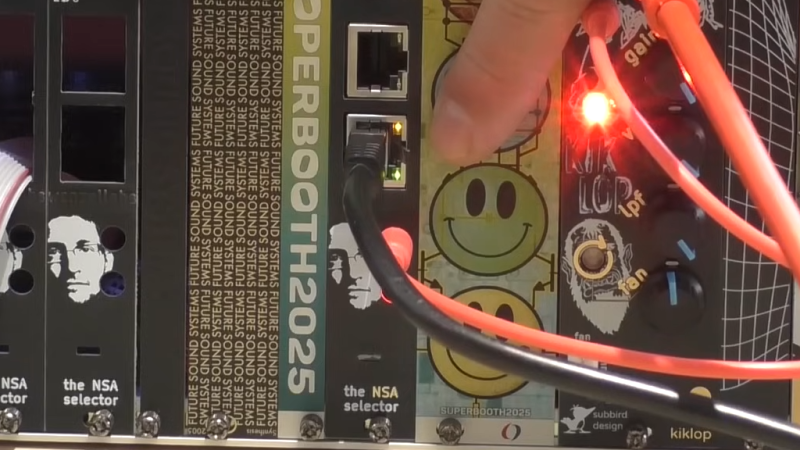Ethernet is how we often network computers together, particularly when they’re too important to leave on a fussy WiFi connection. Have you ever thought about listening to Ethernet signals, though? Well, you totally could, with the NSA selector from [wenzellabs].
The NSA selector is a Eurorack module, designed for use as part of a larger modular synthesizer. There are lots of fun jokes and references on the PCB, but the front panel really shows you what this module is all about. It’s got a pair of RJ45 jacks, ready to receive your Ethernet cables through which data is flowing. They’re paired with a single audio output jack. “Any bit on the network will be sent to the audio output,” [wenzellabs] explains.
The device operates in a relatively simple fashion. Network traffic from one jack is forwarded to the other, unmodified. However, it’s also spat out to a simple digital-to-analog converter and turned into audio. This thing doesn’t play digital audio formats or anything like that—it just turns raw Ethernet signalling into audible noise.
Raw signal noises might not sound very appealing, but let’s be real here. If you liked nice sounds, you wouldn’t be into Eurorack. Skip to 25:46 in the video below if you just want to hear the final product.
Thanks to [mazzoo] for the tip!















Love it, but by god, don’t put your headphones on until 10 seconds in, that bag is loud
Back to the future.
Greybeards remember listening to speakers attached to mainframe/minicomputer CPUs, to keep an ear on how computation was progressing (or not)
I think we need to develop more terminology (well, slang), as techies age. At 50 I’m definitely a graybeard, but even I’m not THAT old!
I did one of these with a frequency divider and delay chip in 08 for a musician in the northeast (had to watch the video to make sure it wasnt him). It wasnt eurorack but the frquency divider makes it oh so much more musical. IIRC there was a dipswitch patchbay too for selecting lines. Not sure whatever became of it or his torroid strummer or him lol. Heck even midi itself with fsk can produce some fun stuff “) Kudos on the build the panel and board are pretty cute :)
Anything going over the network is likely to be fairly efficiently coded, meaning by definition that payload data will sound like white noise. Any tonality you hear will come from regularly repeated bit patterns, which is just going to be the frame and packet headers, which will be at a fairly constant pitch. I guess TCP congestion might cause the pitch to vary in some cases, but for the most part you’ll just hear a screeching when there’s traffic and silence otherwise.
Which is still interesting, and I bet you could learn to hear things like how much strain an HTTP server is under. But it makes me wonder if there are simple ways to process the signal that would expose more information and/or make nicer sounds.
Like say, have inbound and outbound frames trigger two different (micro)samples. Or maybe have a range of microsounds mapped to the source and destination fields in IP headers, so you’d hear a difference between different connections. I’m quite keen to try this now I think about it.
In terms of the actual packet payload, one hopes (in this day and age) that the majority of the traffic will be HTTPS, and if any processing of that can reveal patterns then TLS isn’t doing its job. The source/destination (and maybe port?) mapping idea is interesting. Tho I’m worried it’s mostly a recipe for the paranoid to become even more so, every time they hear a tone they think they don’t recognize.
I can think of only two use cases for this. The first being a sort of general indication that there is either network traffic or not, useful in the sense of “why is their network traffic nothing‘s going on maybe I should go look at a network sniffer if I’m actually curious,.
The other, well really the only, use case is for making music from something not intended to be music, of which there is a hundreds of years tradition. In modular synthesizer land this would probably be used as a trigger or control of other modules.
Imagine if it turns out it was just the modem handshake screeches for the dialup days, just… faster or something.
You can do this by sticking a photocell to the blinking led on a ethernet hub if you just want to listen to bits.
Reminds me of putting an a.m. radio next to the computer. But that was with computers that didn’t really even have operating systems much less multiple threads and cores. Actually the first time I saw/heard someone do that core was memory.